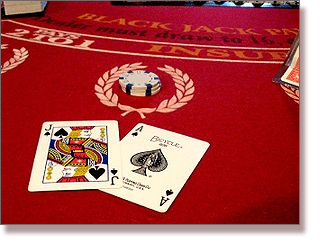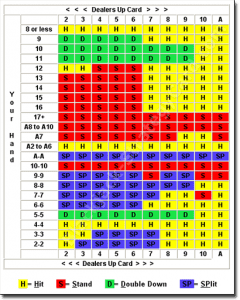 Blackjack is one of the most popular card games within Australia. While the amount of different variations of the game is abundant, it is important to try and play with the more traditional rules when following basic blackjack strategy.
Blackjack is one of the most popular card games within Australia. While the amount of different variations of the game is abundant, it is important to try and play with the more traditional rules when following basic blackjack strategy.
For instance, Melbourne’s Crown Casino has recently introduced the game of Blackjack Plus, where if the dealer draws to 22, a stand-off/tie is implemented, rather than a dealer bust. If the player draws to 22 however, he/she busts. Traditionally, a blackjack hand (Ace and a Ten/face card) pays 3:2, but many variants hold a different pay out of 6:5, or even 1:1. Both of the above rules severely hinder a player’s odds, so it is best to steer clear of such titles.
Featured Casinos
Following basic strategy is the best way to maximise our chances of coming out ahead. Like all casino games, there is always an edge in favour of the house, but with some savvy percentage plays, we can firmly reduce the casino’s advantage. With a simple goal to get as close to 21 as possible without exceeding it, and beating the dealer’s hand, smart decision-making goes a long way. Some of the greatest minds to play blackjack developed the basic strategy chart, which explains what moves should be made in every case scenario, to maximise your chance of success. Having a copy of the chart itself, or the worded explanation of the chart is definitely acceptable (just make sure you don’t hold up play, if playing with others).
Basic strategy chart explained
 If you’re not familiar with the basic strategy chart, it is a detailed table which pits every possible player hand against the dealer’s face-up card, and suggests what should be done with the player hand, depending on what the dealer has. In the following sections, we will transcribe the chart in plain English, so it is easily understandable. It applies to games with four-eight decks, where the dealer stands on all 17s, and checks for blackjack before players play their hands. When doubling is suggested below, only do so if allowed, otherwise hit.
If you’re not familiar with the basic strategy chart, it is a detailed table which pits every possible player hand against the dealer’s face-up card, and suggests what should be done with the player hand, depending on what the dealer has. In the following sections, we will transcribe the chart in plain English, so it is easily understandable. It applies to games with four-eight decks, where the dealer stands on all 17s, and checks for blackjack before players play their hands. When doubling is suggested below, only do so if allowed, otherwise hit.
Hard hands
A hard hand is any hand without an Ace, or with an Ace which is forced to count as one point. For instance, a Ten/Five/Ace is classified as a hard-16, because if dealt in that order, the Ace can only count a one point (otherwise, at 11 points, it would bust the hand). The guidelines of the basic strategy chart advise players to stand on any hard hand worth 17 or more, because they are in a strong position, and chances of a bust are significantly high if drawing another card. Player hard hands totalling between 12 and 16 can also be referred to as stiff hands. Here, the player can bust with one additional card, but is more unlikely than likely to have a strong enough hand to defeat the dealer.
- Any hard hand valued between four and eight points (inclusive) should be hit. Hard hands valued at nine points should be doubled if the dealer shows a Trey through to a Six, otherwise hit.
- If you have a hard-10 and the dealer does not have an Ace or a Ten, you should double down to take advantage of your superior position. If you have a hard-11 and the dealer does not have an Ace, you should also double your bet. If the dealer does show any of those aforementioned cards with your respective hard hand, simply hit.
- If you hold a hard-12, and the dealer shows a Deuce or a Trey, you should hit. Stand if the dealer has a Four, Five or Six, because now there is a strong chance of a dealer bust. If the dealer has a Seven or anything higher, the player should hit to try and wrestle back the advantage.
- If the player holds a hard-13 through to a hard-16, it is advisable to stand if the dealer’s up-card is a Six or anything below, and hit if the dealer has a Seven or any card higher.
- If you have a hard hand between 17 and 20, as mentioned above, you should always stand. Obviously, hands totalling 21 automatically stand.
Soft hands
Any hand that contains an Ace, where the Ace can count as either one or 11 points, is called a soft hand. For example, a hand with an Ace and a Five can either be scored at six points, or 16. In this particular case, basic strategy and common sense says you should always hit no matter what, because you cannot bust and your hand is probably not strong enough to win.
- If you have an Ace/Deuce (soft-13) or Ace/Trey (soft-14), it is suggested to double down if the dealer shows a Four or Five, otherwise hit if the dealer shows anything else.
- With an Ace/Four (soft-15) and Ace/Five (soft-16), the player should double on a dealer Four, Five or Six, otherwise hit on all other cards.
- With an Ace/Six (soft-17), the player should double if the dealer has a Trey through to a Six, and hit on the remaining cards.
- With an Ace/Seven (soft-18), the player should stand if the dealer shows a Deuce, Seven or Eight. If the dealer holds a Trey through to a Six, the player should double. If the dealer has a Nine or Ten, the best option is to hit.
- With an Ace/Eight (soft-19) or Ace/Nine (soft-20), the player should always stand. The odds of reaching a stronger hand by hitting are very low.
Pair hands
When you have been dealt two cards of the same rank (for example, two Aces), the ‘split’ option (in most games) becomes available. The power of the Ace should be ingrained in a player’s mind, and all should know to always split a pair of Aces, because it increases their chances of drawing blackjack, and they will be left with a hard-12 (a stiff hand) if they don’t. Once two Aces are split, the two new hands are each given another card. If a Ten/face-card is drawn to either hand, you have blackjack.
Some games have rules regarding splitting Aces, where you can only receive one additional card for each Ace, while a rule which is even rarer (but does exist) states you can’t split any cards at all. Try avoid these games. Rules regarding re-splitting cards (if cards have been split, and then another card of the same rank is again dealt to a hand) also change from game to game.
- If you had a pair of Tens, always stand, because a hard-20 leaves you in a very strong position, regardless of what the dealer has.
- A pair of Nines should be split if the dealer has a Deuce through to a Six, an Eight or a Nine. If the dealer has a Seven, Ten or Ace, you should stand with your two Nines.
- Two Eights should always be split, regardless of what the dealer has, because together, the hand totals 16; a stiff hand, leaving you in a weak position. Splitting them monumentally increases your chances to draw two better hands.
- A pair of Sevens: if the dealer shows a Deuce through to a Seven, you should split your cards. But if the dealer has an Eight or any card higher, simply hit, as the dealer is in a slightly superior position.
- Two Sixes: if the dealer has a Deuce through to a Six, split your pair of Sixes, but if the dealer has a Seven or any higher card, risk busting and hit.
- Basic strategy suggests never to split a pair of Fives. Rather, you should double down if the dealer has a Deuce through to a Nine. If the dealer has a 10 or Ace, your best bet is to hit.
- Unless the rules allow you to double down after splitting, always hit, rather than split, a pair of Fours. If the rules do allow you to double after splitting, then only split Fours if the dealer shows a Five or Six.
- Act accordingly with a pair of Deuces or Treys: if the dealer has a Deuce through to a Seven, you should split your pair. If the dealer has anything higher than a Seven, your best option is to hit.
The above set of rules are fine to adhere to for games where the dealer hits on a soft-17, too. But for perfectionists, if playing a game where the dealer hits on a soft-17, you can make the following changes:
- Double on 11 against a dealer Ace.
- Double on a soft-18 against a dealer Deuce.
- Double on a soft-19 against a dealer Six.
Insurance in blackjack
If the dealer shows an Ace as his/her up-card, players will usually be offered insurance: if you take up this offer, you put forward half your original bet to ‘insure’ against a dealer blackjack. If the dealer has blackjack, you win the insurance side-bet (2:1 odds), but you will lose your original bet, thus breaking even. If the dealer doesn’t have blackjack, you lose the insurance bet and play out the rest of your hand. We advise never to bother with insurance, as the odds are not in favour of the player.
Perfect pairs
This side-bet is available in most games, and allows us to place a wager (in additional to our regular blackjack bet) on cards of the same rank (two Kings, two Fours, etc.) being dealt as the first two cards. While it is a popular wager and provides some added entertainment value, the house edge is around six per cent, so the perfect pairs option is not profitable in the long run.
